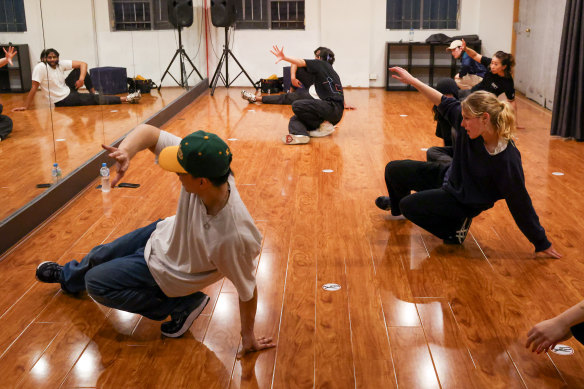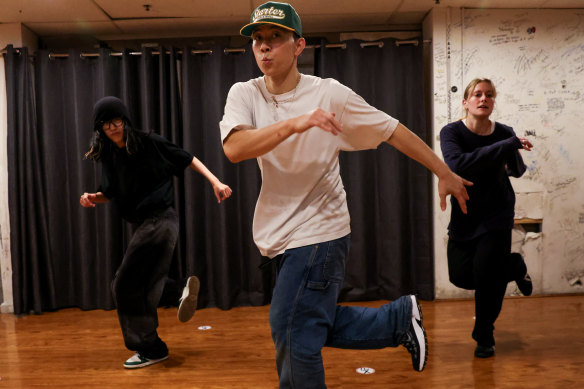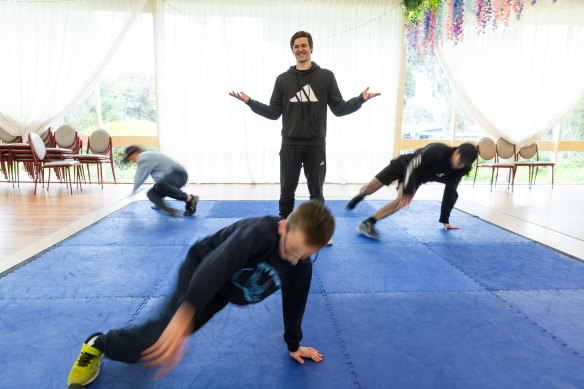Street dance or serious sport? What I learned in my night as a b-girl
By Frances Howe
I tried to avoid meeting my own eyes when facing the tall mirrors of Sydney’s Crossover Dance Studios, but the reflective glass taunted me as b-boy Ota Kohey led a warm-up to kick off Thursday night’s beginner breaking class.
It’s one thing to attempt an Olympic sport on your own just to see if you are able. It’s an entirely different thing to attempt an Olympic sport in front of other people, and worse, in front of a mirror.
Because I refused to stare at myself, and the track pants I’d bought an hour earlier for the occasion, I could only look at Kohey, who oozed the coolness that seems to be a prerequisite for anyone who gets remotely good at breaking. I was yet to ooze anything but a light sweat.

B-boy Kohey, my new tracksuit pants and I in studio 3 of Crossover Dance Studios in Sydney.Credit: Edwina Pickles
Breaking is easily the Olympics’ most contested sport, having been included this year for the first time, with spectators and participants alike questioning the validity of its place in Paris.
Kohey, 37, is one of six members of the Sydney-based breaking crew called Vanguards of Style, the same crew that Australian Olympian Rachael Gunn and her coach are a part of. But he wasn’t certain about having breaking in the Olympics. And it turns out that he’s not the only b-boy that feels this way.
“It’s good for opportunities for us because breaking is too underground, so it’s good to see the Olympics or TV programs show that breaking exists somewhere,” Kohey, who is in his 17th year as a breaker, said. But, he points out, “the athlete’s side of breaking is over there, not the street side.”
Originating in the 1970s in The Bronx, floor work and tricks set breaking apart from other street dancing genres that were developing at the same time. Hip-hop music, street wear and a strong sense of community all contribute to the culture. Some critics argue that it isn’t a sport. Others are less concerned with the dichotomy of sport and art, and instead believe that the real issue is that the culture of breaking will be co-opted.
Following in the footsteps of his father, who was a breaker with his crew the Dynamic Floor Masters (DFM) in the eighties, Anastasios Repousi (b-boy name Tass), 33, started breaking when he was 14, had won a national Redbull one-on-one battle by 16 and had bagged first place in Australia’s Got Talent with Justice Crew by 19.
He believes the stricter format of the Olympics and similar competitions interfere with a breaker’s instincts. “It’s starting to shape breakers to fit that mould. So even though breakers are doing different moves, they’re starting to look the same,” he said. “Breakers will say ‘I’m going to voluntarily shackle myself to these rules so that I can win a medal.’”

I struggled to keep up with b-boy Kohey (centre) and 29-year-old Fino Lin (left), who has taken this class a couple of times before.Credit: Edwina Pickles
But Repousi predicts that reaching a younger generation will allow the Australian scene to develop.
In my dance studio, I was learning the craft with a handful of fellow novices and some with a bit more experience. When the beat drops and Kohey instructs us to glide along, we’re taught to do a basic rocking step. The key isn’t to worry about looking silly but instead to try and find a groove that sits right.
It didn’t matter how suitable for beginners the choreography was, learning how to execute the moves with the kind of comfort and artistry that breakers have would clearly take a lot longer to learn.
The same night I was manoeuvring my new track pants into unrecognisable shapes, Michael Fox (b-boy Flyin Foxy), 34, was leading a breaking class in Melbourne. Fox has been breaking for 25 years and like many in the community, he’s eager to teach the next generation.
“We’re currently at the start of a wave, and I’m already seeing a huge influx of students,” Fox said of the Olympics. But he, like the others, is a sceptic of the sport going this mainstream.

Michael Fox (b-boy Flyin Foxy) and some of his breaking students.Credit: Jason South
For one, breaking battles, known as jams, normally allow for “cyphers”, which are dance circles that organically branch out from the main battle. The Olympics isn’t likely to leave any room for cyphers and organic battles.
“I don’t think it’ll be replicated in the Olympics because I doubt they’ll get people up from the crowd,” Fox said.
Those in the breaking community in Australia are clearly trying juggle the tensions of the sport. While everyone I spoke to was eager to acknowledge that the Olympics were likely to attract more recognition, more students and more opportunities, they also shared a desire to protect an art form that relies on authenticity and originality.
After my first class, I asked Repousi for his advice for beginners like me. He said that learning the culture and history of breaking is critical to those just starting – it’s a nod to the dance’s cultural history.
“Only once you’ve understood the history and the foundation have you earned the right to break the way you want to break,” he said.
While I’ll be resting my muscles (and ego) after my attempt at breaking, I’ll still tune in to watch the sport at the Olympics. After all, it might be the first and last time that we get to watch breaking on this stage.
Start the day with a summary of the day’s most important and interesting stories, analysis and insights. Sign up for our Morning Edition newsletter.